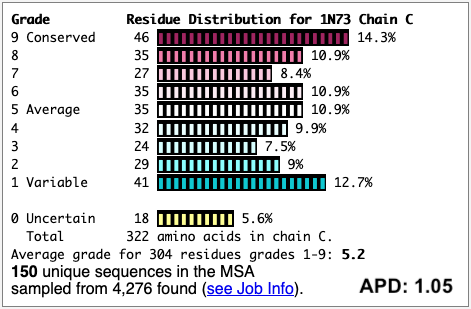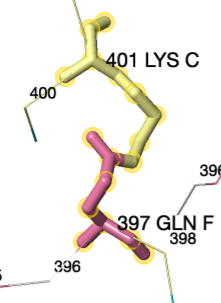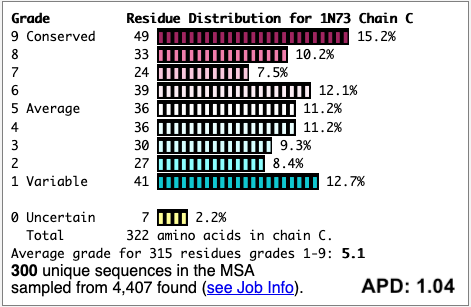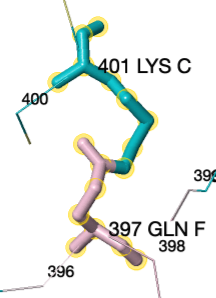Interpreting ConSurf Results
From Proteopedia
This page discusses how to decide whether a ConSurf result is optimal for the questions you wish to ask about a protein. It assumes that you already have one or more completed ConSurf results. For background principles and instructions on how to get a ConSurf result, please see ConSurf/Index.
This page does not go into detail about the changes in settings needed to optimize a ConSurf results. The options for increasing (or decreasing) the diversity and number of sequences in the underlying multiple sequence alignment (MSA) are evident in the job submission forms of ConSurf. You are encouraged to try various options, and the information below will help you to decide which options give the most satisfactory result for your purposes.
Contents |
Diversity in the MSA
A ConSurf result depends crucially on the sequences included in the multiple sequence alignment (MSA). The optimal diversity in those sequences depends on your goal. The diversity in an MSA is quantitated by the #Average Pairwise Distance (APD).
- If you want to know which residues are important for the specific function of one protein, then the MSA should not include proteins with different functions. See Limiting ConSurf Analysis to Proteins of a Single Function.
- If you want to know which residues remain important throughout an entire protein family (or superfamily), then the MSA should be broad enough to include representives of the entire family. Conserved residues will include residues that are conserved to enable proper folding of the domain. Such an MSA may obscure conservation of some residues important for a specific function.
For more about this, see What is the best way to collect homologous sequences in order to construct an MSA? at the ConSurf Server.
Average Pairwise Distance
The average pairwise distance (APD) in a multiple sequence alignment (MSA) is a measure of the evolutionary diversity in the sequences included. The APD is "The average number of replacements between any two sequences in the alignment; A distance of 0.01 means that on average, the expected replacement for every 100 positions is 1." (quoted from the ConSurf Server).
Generally, an APD of 0.25 to 0.5 is consistent with an MSA whose sequences are limited to proteins with one specific function. As the APD approaches or exceeds 1.0, it is more likely that proteins of multiple functions are included in the MSA.
Example
At the ConSurf Server, click on Gallery, then MHC Class I heavy chain (2VAA). In the finished results for chain A of 2VAA, under the subheading Sequence Data, click on Sequences Used.
APD 0.99
The APD for the ConSurf Server 2VAA result with default settings in the Gallery is 0.99. The MSA has 150 sequences, largely limited to sequences for major histocompatibility complex class I proteins. The labels of 101 sequences (67% of 150) contain "class I" or "class 1". There is only one class II protein sequence. Three sequences are labeled "zinc-alpha-2-glycoprotein", clearly a different function. There are 22 sequences labeled "uncharacterized protein" which nevertheless have high similarity to the query. 19 sequences are labeled "UPI000... related cluster". If the uncharacterized and "UPI000..." sequences are in fact class I sequences, then up to 142/150 (95%) of the sequences could be MHC-I.
However, conservation of key functional residues was revealed only when custom ConSurf Server jobs achieved APD around 0.30: See Case #1 atConSurfDB_vs._ConSurf#Examples.
APD 1.62
In contrast, ConSurfDB used 300 sequences for its 2VAA chain A result. The APD is 1.62, suggesting that a number of non-MHC-I proteins were included in the MSA. Only 146/300 sequences (49% of 300 total) in the MSA have labels that include "class I" (excluding the count with "class II"). The MSA includes 62 sequences labeled "Ig-like domain-containing protein", 20 "T-cell surface glycoprotein" sequences of the CD1 family, 17 apparently unrelated proteins (one or a few each), 14 histocompatibility class II proteins, 8 sequences for "hereditary hemochromatosis protein", 8 for "zinc-alpha-2-glycoprotein", and 11 uncharacterized proteins. Excluding the uncharacterized proteins, that leaves 129 (43% of 300) that do not or may not function as MHC I proteins.
Distribution of Residues
FirstGlance in Jmol shows the distribution of amino acids across the 9 conservation grades. This helps to alert you to problems with the MSA. Some examples follow.
|
At the ConSurf Server results page, download the PDB file by opening High Resolution Figures and PDB Files, and then clicking Download ConSurf PDB File for FirstGlance in Jmol. Then upload it to FirstGlance. By downloading the PDB file, you will have it after the results disappear from the ConSurf Server. PDB files downloaded from the ConSurf Database (ConSurfDB) do not work in FirstGlance. |
Good Distributions: 150 Sequences
Here are some examples of distributions for satisfactory ConSurf results.
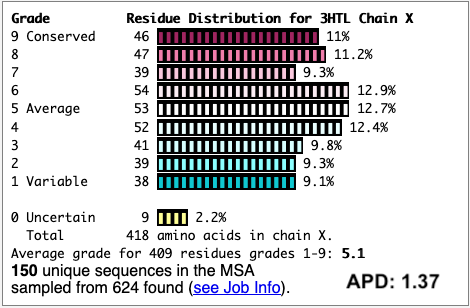
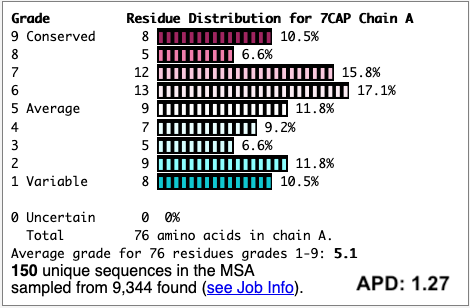
Good Distributions: <100 Sequences
Satisfactory results are sometimes obtained when fewer than 100 unique sequences are obtained. In the case of 1sy7, similar results were obtained for 43 sequences (total unique sequences found) vs. 150 sequences (sampled from 22,855 unique sequences). The APD values were close, and 75% of the residues with the highest conservation grade 9 were in common.
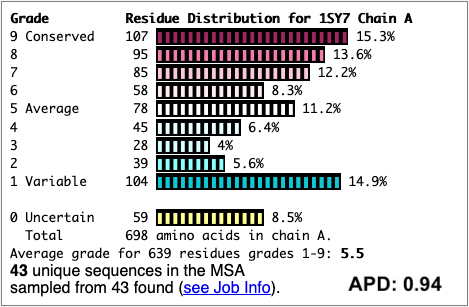
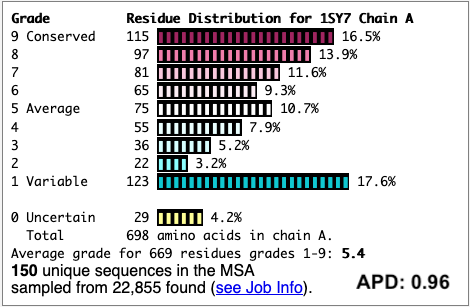
Here are more cases of satisfactory results from <100 sequences:
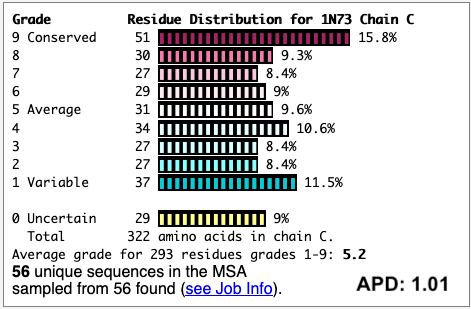
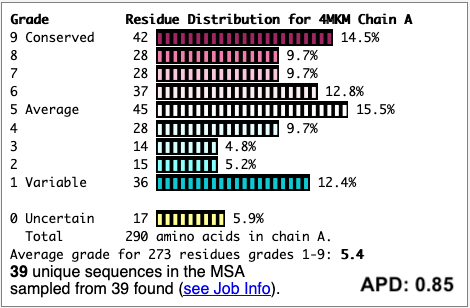
Poor Distributions: Too Few Sequences
When the number of sequences falls below roughly 25, the result is unlikely to be satisfactory. The distribution alerts you to the problem. In such cases, the percentage of residues with insufficient data (uncertain conservation grades) rises, and the average conservation grade for residues assigned grades 1-9 tends to be >5.5.

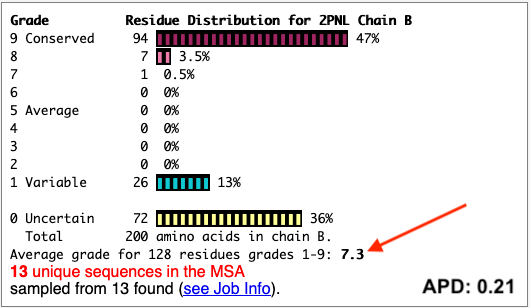
Poor Distributions: Short Chains
Protein chains with fewer than 50 residues may give unsatisfactory results. The collagen in 6vzx has only 24 amino acids/chain. Increasing the number of sequences in the MSA did little to improve the result.
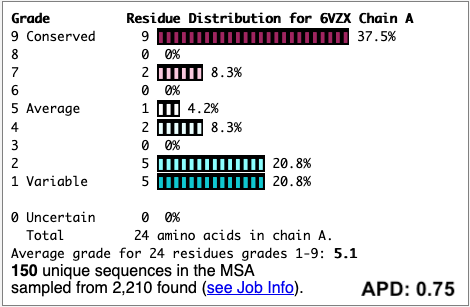
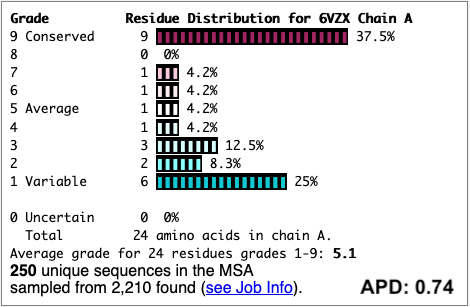
Too Many Residues With Insufficient Data
Amino acids with insufficient data (uncertainty in conservation grade) are colored yellow. Here are two cases where yellow residues were a problem, with solutions.
More Sequences Needed
If a residue of interest has insufficient data, increasing the number of sequences in the MSA may give it a reliable conservation grade. This happened for sequence-identical chains C and F in 1n73. With 150 sequences (default job settings), Lys401, participating in an isopeptide bond, had insufficient data. When 300 sequences were used in the MSA, Lys401 acquired a reliable conservation grade of 1. Its partner in the isopeptide bond, Gln397, dropped from conservation grade 8 to 7, although the APD did not increase.
FirstGlance automatically reports six types of protein crosslinks, including isopeptide bonds. Other examples of protein crosslinks colored by evolutionary conservation are a thioether crosslink in catalase and an isopeptide in poly-ubiquitin.
Entire Domain With Insufficient Data
In some cases, the MSA fails to cover an entire domain adequately, so the entire domain is yellow. With default job settings and automatic sequence selection, this happened for 2yev chain A. As the ConSurf server explains, the solution to this is to run each domain as a separate ConSurf job (not shown). Here are instructions for separating domains into different PDB files.


See Also
- ConSurf/Index: Links to explanations of the principles of evolutionary conservation, as well as practical guidance.
- FirstGlance/Visualizing Conservation: Demonstrates the conveniences offered by FirstGlance for easily seeing conservation of salt bridges, cation-pi interactions, residues that bind ligand, substrate, or inhibitor, residues in covalent protein crosslinks, or any residues that you specify.
